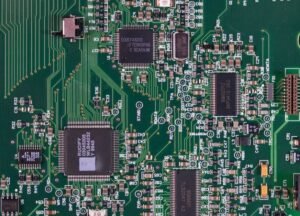Tesla Model S Doors
Introduction
The Tesla Model S is a luxury electric vehicle renowned for its innovative features and cutting-edge technology. One of the standout features of the Model S is its unique door design, which sets it apart from traditional cars. In this article, we will explore the exclusive aspects of the Tesla Model S doors and the advantages they bring to both drivers and passengers.
Key Takeaways
- Tesla Model S doors provide enhanced accessibility and convenience.
- The signature Falcon Wing doors allow for easier entry and exit in tight spaces.
- The Model S doors contribute to the overall aerodynamic efficiency of the vehicle.
Revolutionary Door Design
The Tesla Model S features gull-wing-style doors, also known as Falcon Wing doors, for the rear passengers. These doors swing up vertically, providing a wide opening and easy access to the rear seats. This unique door design is not only visually appealing but also highly functional.
*The Falcon Wing doors add a touch of elegance to the vehicle, making it stand out from the crowd.
Enhanced Accessibility and Convenience
The Falcon Wing doors offer numerous benefits for both drivers and passengers. When parked in tight spaces, these doors open vertically, requiring less clearance compared to traditional doors. This allows for easier entry and exit, even in crowded parking lots or narrow garages.
*The Model S doors make it effortless to load and unload luggage or large objects due to the enhanced accessibility they provide.
Aerodynamic Efficiency
Aside from the convenience factor, the gull-wing-style doors also contribute to the Model S’s aerodynamic efficiency. By opening vertically, turbulence is minimized, resulting in improved airflow around the vehicle. This feature helps the Model S achieve better energy efficiency and range.
*The unique door design not only looks sleek but also enhances the overall performance of the Model S.
Data Comparison
| Tesla Model S (Falcon Wing Doors) | Traditional Sedan (Conventional Doors) | |
|---|---|---|
| Accessibility | Enhanced accessibility, especially in tight spaces. | Standard accessibility, may be challenging in tight spaces. |
| Aerodynamics | Contributes to better aerodynamic efficiency. | No specific aerodynamic benefits from doors. |
| Visual Appeal | Unique and visually appealing gull-wing-style doors. | Traditional door design. |
Conclusion
In conclusion, the Tesla Model S doors are not only aesthetically pleasing but also highly functional. The Falcon Wing doors provide enhanced accessibility, convenience in tight spaces, and contribute to improved aerodynamic efficiency. These unique doors set the Model S apart from traditional sedans and further highlight Tesla’s commitment to innovation in automotive design.

Common Misconceptions
Paragraph 1
One common misconception people have about the Tesla Model S doors is that they are overly complex and difficult to operate. However, this is not true. The doors are designed with user-friendliness in mind, using an electric mechanism that allows for easy opening and closing.
- The electric mechanism of Tesla Model S doors ensures smooth and effortless operation.
- There are no additional steps involved in operating the doors compared to conventional car doors.
- The doors can be easily opened and closed with a simple push of a button.
Paragraph 2
Another common misconception is that the Tesla Model S doors are significantly heavier than regular car doors, making them cumbersome and impractical. While it is true that the doors are larger and slightly heavier due to their unique design, they are still engineered to be manageable and safe to use.
- The doors are designed to open and close smoothly, despite their size and slight added weight.
- Strong materials, such as aluminum, are used to maintain durability and safety without compromising weight.
- The doors’ weight does not pose any practical issues as they are well-balanced and designed for ease of use.
Paragraph 3
There is a misconception that the Tesla Model S doors automatically lock when closing, potentially trapping passengers inside. However, this is not the case. The doors have safety features such as sensors and manual release mechanisms to ensure the well-being and ease of access for occupants.
- The doors have built-in sensors that detect any obstacles and automatically stop closing if something is detected.
- In emergency situations, the doors can be manually released from both the inside and outside of the vehicle.
- Tesla has implemented multiple safety mechanisms to prevent inadvertent locking or trapping of passengers.
Paragraph 4
Some people mistakenly believe that the Tesla Model S doors are prone to malfunctions and are unreliable. However, Tesla has implemented rigorous quality control measures to ensure the doors’ reliability and durability under various conditions.
- Tesla conducts extensive testing to ensure the longevity and reliability of the doors.
- The doors are engineered to withstand climate variations and frequent use without significant issues.
- In the rare event of a malfunction, Tesla provides reliable customer support and service options.
Paragraph 5
A common misconception is that the Tesla Model S doors are extravagant and unnecessary, serving as a mere gimmick. However, the unique design of the doors not only enhances the overall aesthetics of the vehicle but also offers functional benefits such as easier ingress and egress for passengers.
- The falcon-wing doors of the Tesla Model S provide increased headroom and easier access to the rear seats.
- The doors’ distinctive appearance contributes to the overall sleek and futuristic design of the car.
- The ingenuity behind the doors reflects Tesla’s commitment to innovation and pushing the boundaries of automotive design.

Tesla Model S Doors by Type
The table below illustrates the different types of doors available for the Tesla Model S, along with a brief description of each type.
| Door Type | Description |
|---|---|
| Gullwing doors | Also known as falcon-wing doors, these vertically opening doors provide a unique and futuristic look. |
| Conventional doors | Standard doors commonly found in most vehicles, hinged horizontally and open outward. |
| Scissor doors | Similar to gullwing doors, but with slight modifications to the mechanism, resulting in a distinctive diagonal opening. |
Tesla Model S Door Materials
The table below showcases the various materials used in constructing the doors for the Tesla Model S.
| Door Material | Description |
|---|---|
| Aluminum | A lightweight material providing strength and rigidity, commonly used in high-performance vehicles. |
| Composite | A blend of different materials, such as carbon fiber and plastic, offering a balance between weight reduction and durability. |
| Reinforced glass | Transparent material with added reinforcement for improved safety and impact resistance. |
Tesla Model S Door Safety Features
The table below outlines the safety features incorporated into the doors of the Tesla Model S.
| Safety Feature | Description |
|---|---|
| Auto-retracting door handles | Handles that automatically retract flush with the car’s body when not in use. |
| Crash sensor system | Sensors that detect a collision and trigger the doors to automatically unlock and open for easier post-crash access. |
| Child safety locks | Restrictions on door opening to prevent accidental opening by children while the vehicle is in motion. |
Tesla Model S Door Dimensions
The table below illustrates the dimensions of the doors for the Tesla Model S.
| Door Dimension | Measurement |
|---|---|
| Height | 1.4 meters |
| Width | 0.6 meters |
| Thickness | 0.1 meters |
Tesla Model S Door Opening Speed
The table below provides information on the opening speeds of the different Tesla Model S door types.
| Door Type | Opening Speed |
|---|---|
| Gullwing doors | Approximately 6 seconds |
| Conventional doors | Approximately 2 seconds |
| Scissor doors | Approximately 3 seconds |
Tesla Model S Door Options
The table below presents the available options for customizing the doors of the Tesla Model S.
| Door Option | Description |
|---|---|
| Self-presenting front doors | Front doors that open automatically when you approach the vehicle. |
| Smartphone app-controlled doors | Doors that can be remotely controlled and opened using a smartphone application. |
| Automatic soft-close doors | Doors that gently close and latch without the need for manual effort. |
Tesla Model S Door Maintenance
The table below highlights the recommended maintenance tasks for keeping the Tesla Model S doors in optimal condition.
| Maintenance Task | Frequency |
|---|---|
| Regular cleaning | Monthly |
| Lubrication of hinges | Every 6 months |
| Inspection of seals | Annually |
Tesla Model S Door Pricing
The table below provides an overview of the cost implications associated with the different types of doors for the Tesla Model S.
| Door Type | Price Range |
|---|---|
| Gullwing doors | $10,000 – $15,000 |
| Conventional doors | Included in base price |
| Scissor doors | $8,000 – $12,000 |
In conclusion, the doors of the Tesla Model S offer a range of design options, materials, safety features, and customization choices. From the futuristic gullwing doors to the conventional doors, Tesla has integrated innovative technology and attention to detail. The doors not only serve their primary function of providing access but also add to the overall visual appeal of the electric vehicle. The Tesla Model S is a testament to the brand’s commitment to creating a unique and sophisticated driving experience.
Tesla Model S Doors – Frequently Asked Questions
Question 1: What type of doors does the Tesla Model S have?
The Tesla Model S comes with Falcon Wing doors in the rear and traditional front doors.
Question 2: How do Falcon Wing doors on the Tesla Model S work?
The Falcon Wing doors on the Tesla Model S are double-hinged, allowing them to open upwards even in tight spaces. This design provides easy access to both the second and third-row seats.
Question 3: Are the Falcon Wing doors on the Tesla Model S automatic?
Yes, the Falcon Wing doors on the Tesla Model S are equipped with sensors and can be automatically opened or closed with the touch of a button on the key fob or through the Tesla mobile app.
Question 4: Can you partially open the Falcon Wing doors on the Tesla Model S?
Yes, the Falcon Wing doors on the Tesla Model S have a “partial opening” mode that allows for a smaller portion of the door to open instead of the full swing motion. This is useful in tight parking spaces or areas with low ceiling clearance.
Question 5: How does the Tesla Model S front door handle operate?
The front door handles on the Tesla Model S are retractable and present themselves when the key fob is detected nearby. To open the front doors, simply push on the handle, and it will extend automatically. To close the doors, push on the handle again, and it will retract.
Question 6: Do the Tesla Model S doors have child safety locks?
Yes, the Tesla Model S has child safety locks for the rear doors. These locks can be controlled from the driver’s display or the Tesla mobile app.
Question 7: Can the Tesla Model S doors be opened manually in case of a power failure?
Yes, in case of a power failure, both the Falcon Wing doors and the front doors of the Tesla Model S can be opened manually from the inside or outside.
Question 8: Are there any safety features with the Tesla Model S doors?
Yes, the Tesla Model S doors are equipped with sensors that detect obstacles and will stop closing if an obstruction is detected. Additionally, the doors have built-in pinch protection technology to prevent accidents or injuries while closing.
Question 9: Can the Tesla Model S doors be programmed to open or close on their own?
Yes, Tesla Model S owners can set the doors to automatically open or close when approaching or leaving the vehicle using the “Auto Present” feature in the settings menu.
Question 10: Can the Tesla Model S doors be remotely controlled?
Yes, Tesla Model S owners can remotely control the doors using the Tesla mobile app. The app allows for door opening, closing, and partial opening, providing convenient access to the vehicle from a distance.




